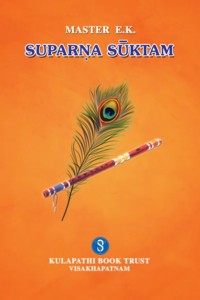Book Presentation
Suparna Suktam. Commentary on the Hymn of Suparna
by Dr Ekkirala Krishnamacharya

The hymn on the book of Suparna is the 164th hymn of the 1st canto (Mandala) of the Rig Veda. It has 52 mantras which are called ‘Riks’. The Ancient Wisdom pertaining to the Light (Jyothir-Vidaya) and salvation (Moksha-Vidya) is extolled in them.
Dr. Ekkirala Ananthacharya has unveiled most of the deep hidden secrets in his English work “Suparna” in the year 1962. Dr. Ekkirala Krishnamacharya (Master EK), the eldest son of Dr. Anantacharya, has written an elaborate commentary on “Suparna Suktam” in Telugu in 1982. It brings out the existing light of synthesis on Suparna and gives the reader a clear understanding of the subject. The English translation of this book from Telugu has been done by Dr. Tejaswi Katravulapally, Ph.D.in in Quantum Physics. He has also written a commentary on Lalitha Sahasranamam in English.
Kulapathi Book Trust, Visakhapatnam, India 2024
Sample:
IntroductionWhat is in the Veda? Is it the artistic descriptions and personifications of powers of Nature? Or is there actually something that the hymns of these scriptures proclaim? If yes, what is it? Is it a routine fact or a special one or is it unique? This ‘Suparna Suktam’ is the answer for all such questions. If one needs to arrive at the right answer, they need to practice the Veda for themselves. Practicing the Veda includes neither mere reading of the texts nor translations. There is a way of practice that has been coming down since the dawn of time.
Following the footsteps and suggestions of the wise ones who tread that path will give the clues on how to practice the Veda. A constant perseverance, in this path, in associating and assimilating different aspects of the Veda will lead one to realize the fact that there is ONE omniscient Lord having the mantras of the Veda as his limbs, that this whole creation is his expanse and that the beings of that creation exist as his seed forms.
Veda itself has some suktas (a suktam is a collection of hymns) that makes the process of learning of an earnest disciple, who is in the above-mentioned path, more easier. They are Purusa suktam, Sri suktam, Visnu suktam, Narayana suktam, Rudra suktam, suktams of Visve Devas, Agni suktam and Suparna suktam.
Thus, this Suparna suktam, being one amongst the many suktas that proclaim the VEDIC essence with clarity, takes a prominent role. In order to clearly explain this suktam and expand its essence, puranas and itihasas have the chapter of ‘Garudopakhyona’ eulogized in them. Suparna of this suktam is described as GARUDA/Eagle-GOD in those chapters.
The mother of the hymns of all the four Vedas is the Rig Veda samhita (collection). Different hymns of the Rig Veda samhita are arranged, re-arranged and transmuted into different parts of the remaining Vedas. All the afore mentioned suktas are part of Rig Veda.
The hymn of the present book of Suparna suktam, is the 164th hymn of the 1st canto (Mandala) of Rig Veda. It is also called by the name Asya Vamasya suktam’. Seer of this sukta is Dirghatamasa’.
It has 52 mantras. These mantras are called ‘Rks'. The ancient wisdom pertaining to the lights (Jyotirvidya) and salvation (moksa-vidya) is extolled in them. Also, there are 32 wisdom paths that form practical manuals for the practice of respective paths. Some of them are explored in this suktam. At respective places, the formulas of the following wisdom paths are given out: Aksi Vidya, Dahara Vidya, Antaraditya Vidya and Pancagni Vidya.
In this sukta, following devas were established as the devas presiding over respective mantras: Visve devas, devas of Vak, Apas, Soma, Agni, Surya, Vasus, Sakadhumam, Kala, Sadhyas and Parjanya. Having all these devas as part of him, Suparna is the main deity of the whole hymn.

 Circle of Good Will
Circle of Good Will Contact
Contact
